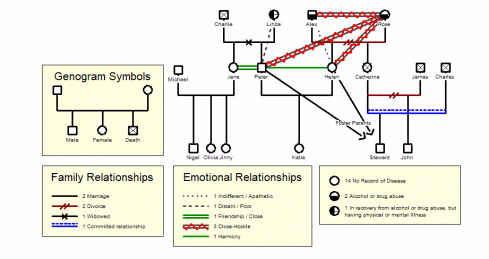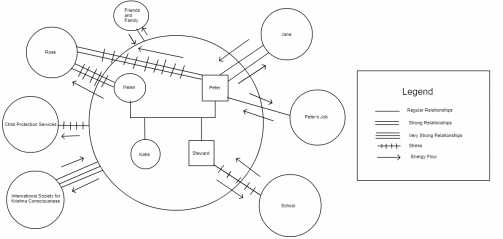Introduction
Nuclear family beliefs and practices affect every aspect of a person’s life. When children grow up, personal relationships between family members determine if they will carry and develop these beliefs in their newly organized nuclear family. The effectiveness of nursing interventions depends on the understanding of these matters and the ability to adapt to non-standard family organization. The present paper examines the functional and communicational patterns inside a family with non-traditional structure and beliefs.
Description of Nuclear Family
The present assessment is focused on a nuclear family of a mother, a father, a daughter, and a foster son. The mother of the family, Helen, is 29 years old, and she has a bachelor’s degree in computer science. The father, Peter, is 31 years of age with a master’s degree in linguistics. He has a stable job and can fully satisfy the financial needs of the family. Katie is a one-year-old daughter with no reported abnormalities in development. Steward is a twelve-year-old boy studying in a middle school. He is a son of Helen’s deceased sister, Catherine, living as a foster child with the family for the past three years. According to developmental theory, on the one hand, the family is at stage two, a childbearing family (Friedman, Bowden, & Jones, 2003). On the other hand, the family is on stage four, as a family with a school-aged foster child.
Sociocultural Data
The family is all white with no recorded relatives being of racial minorities. All the members of the nuclear family follow Hindu traditions in values, celebrations, dietary habits, and healthcare beliefs. Even though not all the extended family welcome Vedic culture, there are little confrontations on a cultural or religious basis. As for the social status, the family belongs to the middle class considering the level of income.
Environment
The environment is friendly with no abnormalities in physical settings. The family lives in a small town in a separate three-bedroom house. Even though the house is not very large, it is comfortable and provides enough space for everyone’s privacy to be respected. The neighborhood is quiet in a cedar grove with a little park near the house. The community mostly consists of older adults, as housing in the area is comparatively cheap. In short, the outside environment of the family is peaceful with no stress coming from living conditions.
Communication
The communication level inside the family is optimal, as everyone is encouraged to express their feelings and judgments freely. The opinions of all the family members are valued, and the parents use effective communication techniques to solve problems and address conflict situations. Even though everyone tends to respect Peter the most, he does not take advantage of that and feels responsible for all the family members. In short, the communicational aspect of the relationships in the family is one of the strongest points.
Power Structure
The parents are clearly the leaders and care for each other and their children. They form a strong parental coalition and provide models of respect and affection for the children. Even though the father is respected the most, leadership is shared between the parents, changing with the nature of the interaction. According to Beavers and Hampson (1990), these are the characteristics of an optimal power structure.
Role Structure and Relationships
The family roles are rationally distributed to perform the functions effectively. Peter is the only working member of the family, while Helen focuses on childrearing. Steward is a student in a middle school with average grades taking all the responsibility for his studies. The decision-making process is clearly defined and everyone, except for Katie, participates in making crucial decisions. As for relationships, the nuclear family lives in harmony while having some stressful relationships with members of the extended family and formal organizations.
The relationships are clearly described in the genogram (Figure 1) and ecomap (Figure 2) provided in the supplements for the present paper. The parents have very close and, at the same time, stressful relationships with Helen’s mother, Rose, who is an alcohol abuser. Steward is struggling with the school as he suffers from the consequences of hydrocephaly. The family also have to communicate with Child Protection Services (CPS) who always insist on vaccinating Steward, while Helen and Peter are strongly against vaccination. However, the spiritual community, the International Society of Krishna Consciousness (ISKCON), compensates for all the stress from other sources. In short, even though the family has to deal with some external disturbance, they adopted effective strategies to overcome the problems.
Spiritual Activities
Faith is the central value of the family, as religious beliefs affect all the aspects of life. As Helen, Peter, and Steward are members of ISKCON, meaning that they are vegetarians and follow the principle of non-violence. They visit the temple every Sunday and go to some of Hindu festivals in the state. The family also has an altar in the house, and they offer their food to Krishna before eating it. In brief, spiritual activities are not traditional for western society.
Values
The values of the family are strongly influenced by religion with Lord Krishna being the center of every activity. As for rules, meat, poultry, and fish are not to be cooked or eaten by anyone visiting the house, and no alcohol is allowed. Additionally, everyone is encouraged to follow a strict schedule, waking up at 4 a.m. and spending an hour in prayers. The family members are also supposed to take a shower every morning. All the values are shared by the family members adding to the atmosphere of mutual understanding.
Socialization and Childrearing
The family seems to socialize normally having birthday parties and meetings with friends. They visit concerts and public celebrations when it is possible. Childrearing process is also well-established centralizing on the children’s individual needs rather than on generalized recommendations. However, if the parents have questions about any issues, they consult specialized organizations, such as hospitals, lawyer, and CPS. In short, there are no abnormalities in this aspect of family life.
Adaptation
The family members demonstrate an optimal ability to adapt to outside circumstances. For instance, the parents accepted Steward as their son when his mother and father passed away. Additionally, the family changed a place of living to keep Steward away from the hostile environment in at school. This example describes the functional coping strategies and the ability to use the problem-solving skills. Therefore, the family seems rather flexible and can adapt to the changing realities.
Healthcare Beliefs
Healthcare beliefs are not traditional, as the parents think if a person gets sick, he or she does not necessarily need to go to the hospital. They believe that sicknesses come from improper lifestyle and tend to go to healthcare institutions only in case of increased concern or emergency. According to VanderWeele, Balboni, and Koh (2017), this situation is typical for religious families. All the family members follow a strict diet and schedule to avoid obesity, diabetes, and other lifestyle-related conditions. Additionally, Helen and Peter practice meditation to promote mental health. However, as mentioned earlier, the parents do not believe in immunization, which may be considered a problem. In short, even though the family supports healthy living, some of the beliefs are concerning.
Interventions
As the family is at stage two and four of development, the list of recommendations for maintaining the family’s health will be diverse. Such families are recommended to visit lectures about child-care, sibling relationships, and parenting (Friedman et al., 2003). Additionally, screening for vision, hearing, speech, behavior, learning, and abuse are to be promoted (Friedman et al., 2003). Moreover, an intervention based on the Health Belief Model is to be advised to change the family’s perspective on immunization. According to Friedman et al. (2003), the parents should be informed about the negative impact of avoiding vaccination and the positive side of taking the recommended action. As immunization is not a complicated matter, the aspect of self-efficacy is not relevant. Nurse education about vaccination is expected to be effective for strengthening the family’s health.
Conclusion
Religion can be helpful for maintaining mental health and promoting healthy communication. However, sometimes spiritual activity may interfere with people making evidence-based decisions. Effective nurse interventions are needed to improve the health status of families.
References
Beavers, W. R., & Hampson, R. B. (1990). Successful families: Assessment and intervention. New York, NY: W. W. Norton & Company.
Friedman, M. M., Bowden, V. R., & Jones, E. G. (2003). Family nursing: Research, theory, and practice (5th ed.). Upper Saddle River, NJ: Prentice Hall.
VanderWeele, T., Balboni, T., & Koh, H. (2017). Health and spirituality. JAMA, 318(6), 519. Web.
Supplements

